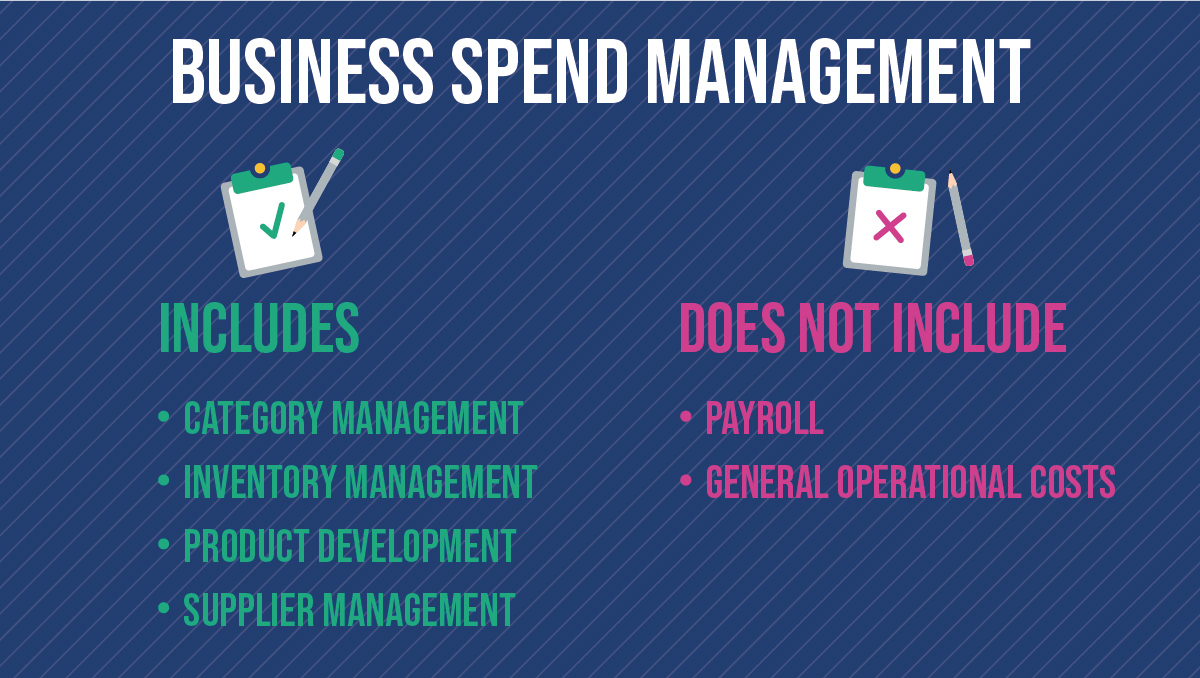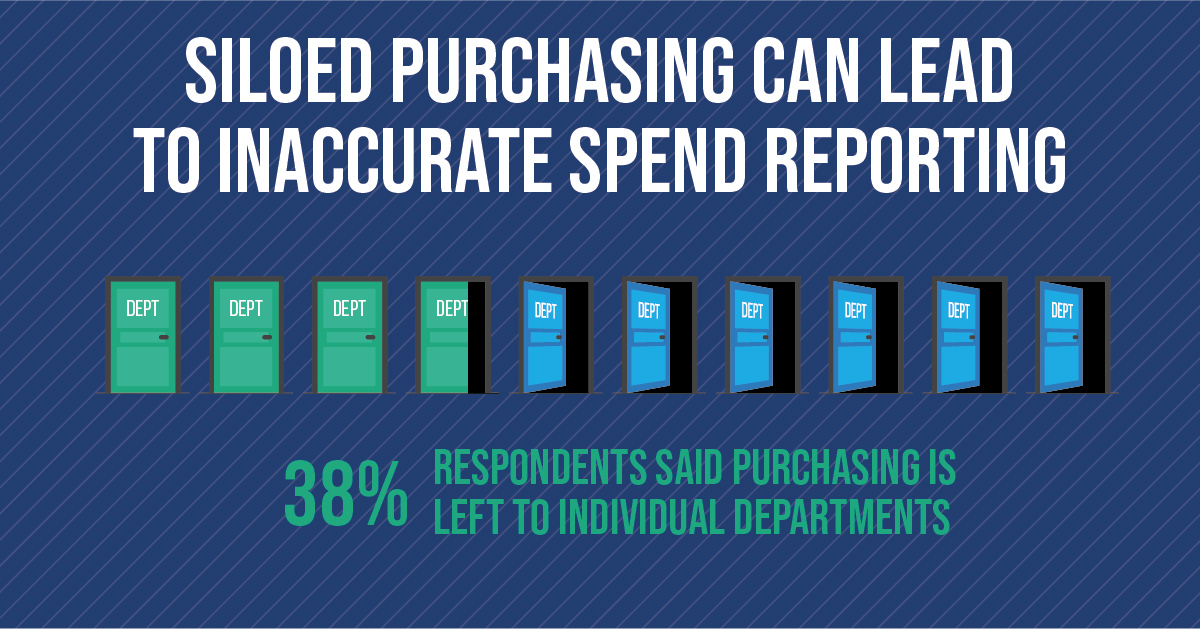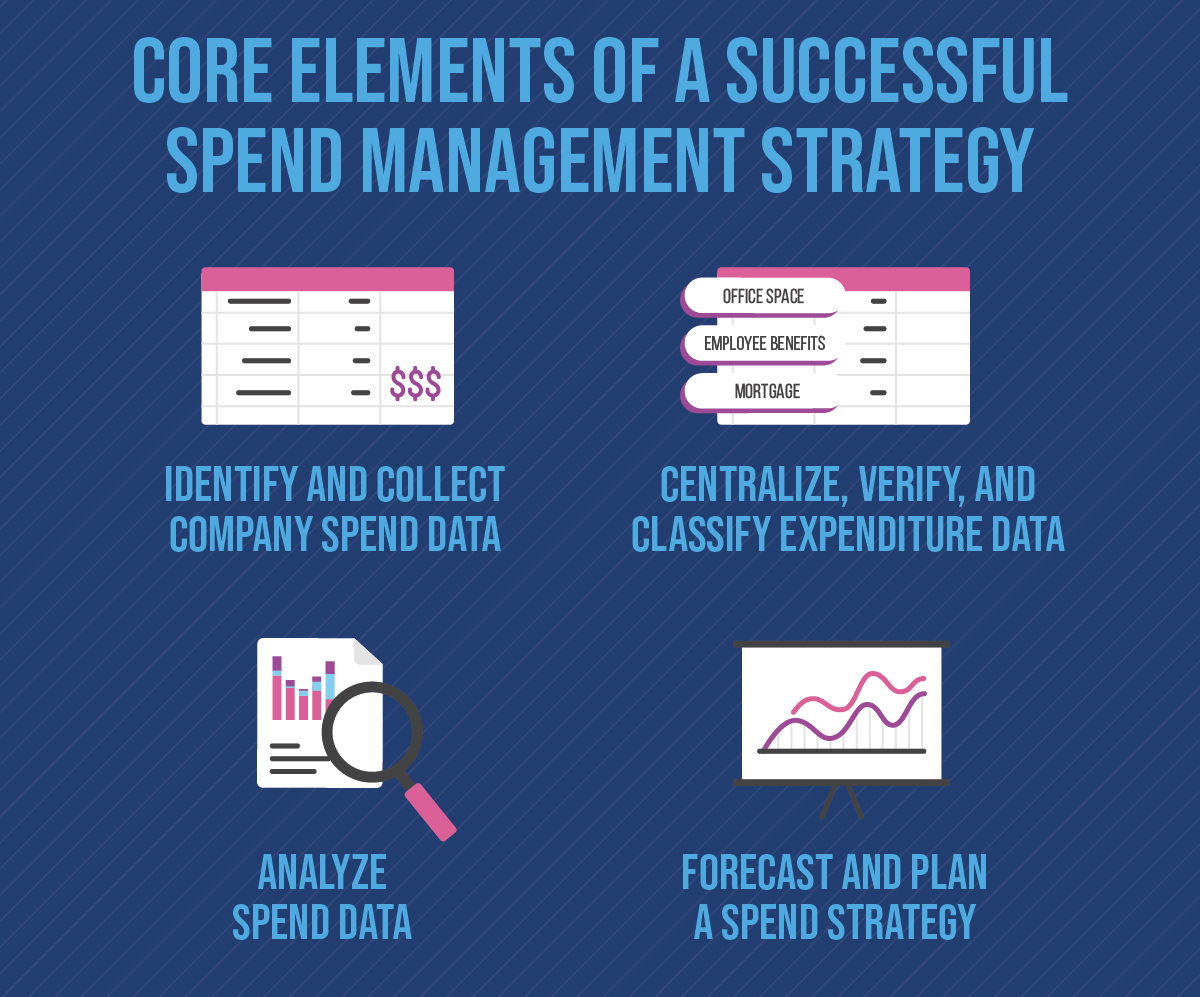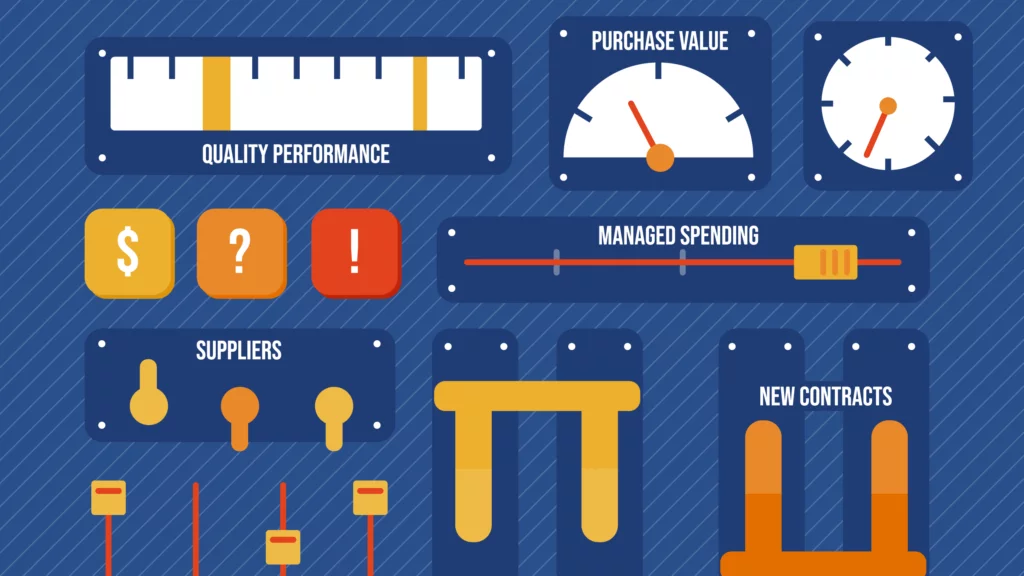Business Spend Management – The Ultimate Strategy Guide

Business Spend Management is a group of processes, systems, and strategies businesses use to track, analyze, manage and control business costs and company spending. Spend management is how businesses maximize profitability while reducing costs, mitigating risk, and maintaining positive relationships with vendors and service providers. It combines supply chain management, contract lifecycle management, budgeting, analytics, sourcing strategy, expense management into a single management system to provide visibility and control over your business expenditures.
Spend management is more critical than ever as supply chain disruptions, rising inflation, and remote work disrupt the global economy. CFOs and accounts payable (AP) departments have to stay on top of short-term and long-term spending to balance business growth with cost-efficiency. If a business doesn’t know where its money is going, it won’t last long in the post-pandemic economy.
The easiest way to think of business spend management is as a continuous process to maximize the ROI of every penny your business spends. A spend management strategy, built on a foundation of accurate, real-time spend data collection and analysis, allows your accounts payable department to maintain control of expenses, optimize vendor and supply relationships, and anticipate and mitigate expense risks.
In this article, we’ll help you:
- Understand what spend management is and why it’s important
- Learn what makes an effective spend management program
- Design a core spend management strategy
- Evaluate spend management tools and automation solutions
What is Spend Management?
Gartner defines business spend management as “a set of practices that ensure organizations make procurement and sourcing decisions in the interests of both the bottom line and company efficiency.” It is a comprehensive approach to managing spend from procurement to pay (P2P) so expenditures are approved and budgeted, vendors and suppliers get paid on time, and contract terms are honored. In short, business spend management pinpoints where a company is losing money, where spend processes and policies can be optimized, reduces and mitigates risk, and manages cash flow.
Business spend management usually includes strategic procurement processes and functions such as category management, inventory management, product development, and supplier management. It doesn’t include payroll or general operational costs. Although it is often associated with procurement functions, business spend management impacts internal and external stakeholders. Spend management works alongside customer relationship management (CRM), enterprise resource planning (ERP), and human capital management (HCM) functions. BSM supports the integration of these functions into a single management system to manage business operations.

Digital Transformation and Integration
Traditionally, businesses managed their spending with manual tools like spreadsheets. These manual methods were inefficient and could be prone to errors if not done correctly.
Today, many businesses are looking at digital solutions to automate their spend management processes. Automation of spend management and integration into other business systems allows for a cost-effective, centralized, sustainable, and scalable solution that provides real-time spend data analytics and control over expenditures. Digital spend management systems provide accounts payable teams with the data and tools to develop a robust spend management strategy and make informed decisions about their expenditures.
Spend Management vs. Expense Management
Spend management is not the same as expense management, although the two functions are related. Expense management is the system that processes and pays employee expenses such as travel. Spend management is the system that controls all spending, including employee expenses. It’s essential to have an effective and efficient expense management process as a component of your business spend management process.
Why Spend Management Is Important
Managing spend isn’t easy, but the costs of not managing spend are high. Poor spend management can lead to low visibility, noncompliance with expense policies, higher transaction costs, and operational inefficiency as AP teams track down and verify expenses. This can harm your business, but it can also affect your customers, suppliers, employees, and shareholders.
Business spend management gives you a company-wide view of spending in real-time to make quick, informed decisions. Here are some of the ways a spend management system can help address common spending pitfalls:
Centralization and Transparency of Spend Data
Spending is not consistent across departments in most businesses. Some departments spend much more than others, and it’s not unusual for individual departments to have their own expense policies. A 2021 survey by Stampli and Treasury Webinars, “AP Today: Bottlenecks, Benchmarks & Best Practices,” found 38% of respondents reported that their companies left purchasing to individual departments. This can leave companies in the dark about the actual amount of money they spend. With the rise in mobile and remote working, eliminating disparate expense policies and procedures is more important than ever.

Spend management can address this situation by capturing spend data in real-time, revealing areas where your business is not spending effectively, and giving you control over what you spend. Since even a slight reduction in costs can significantly impact your bottom line, controlling spending can substantially affect the profitability of your business.
Clear Expense Policy and Procedures
If employees don’t know your expense policy, or if you’ve got different expense policies for various departments, it will be difficult for them to understand the spending policies and how they submit their expense claims. This can result in higher costs and inefficiencies. By implementing a comprehensive expense policy based on a data-backed spend management strategy and managed in real-time, you can make your expense policy and procedures clear and straightforward. You can track and control expenditures and reimbursements in real-time to ensure employees are compliant with the policy.
Reduce Spending Errors and Fraud
Unclear policies, inefficient paper-based manual expense procedures, and inadequate spend data tracking leave you at risk of losses due to human error and fraud. Incorrectly entered data, mistakes during approval, fraudulent claims, and other errors can slip through the cracks.
By tracking spend data and approving expenses in real-time, you can quickly detect and mitigate errors and fraud and save your business money.
Support Business Growth
For most businesses, growth means spending a lot of money. If spending isn’t controlled and managed correctly, it can lead to missed opportunities and cash shortfalls, neither of which are suitable for the growth of your business.
A spend management solution can make it easier for you to manage the high volume and speed of increased spending to support growth. With real-time visibility into your expenditures, you always know how much money you have on hand to invest in new opportunities. You can detect and address minor problems quickly before they have the chance to grow into big ones.
Having accurate and up-to-date financial and performance data also doesn’t hurt when your business wants to attract investors.
Make Data-Driven Spend Management Decisions to Grow ROI
It is important to track, analyze and manage your business expenditures in every aspect of your organization. A data-driven spend management strategy provides for long-term management of your business costs. It also provides a solid foundation for business growth. This is because having accurate, timely data on your spending will give you insights that will save your company money and allow you to invest those savings into activities that grow your business.
Build a Spend Management Strategy
Managing business spend will save money and boost your bottom line, but that’s only half the story. To manage cash flow for growth, you need to build a long-term spend management strategy that prioritizes and optimizes your business expenditures for ROI.
What is Strategic Spend Management and What Does it Do?
Strategic spend management is the process of designing, planning, developing, and implementing spend controls, systems, and processes to ensure a high profit-loss ratio on expenditures. A spend management strategy should be aligned with business strategy and goals, based on sound data and analytics, and focused on maximizing spend ROI. Your strategy should include plans for simplifying expense processes and procedures, integrating business spend management tools with other business processes and tools, and collecting, analyzing, and reconciling spend data.
A good spend management strategy forms the foundation and roadmap for your business spend management. It provides smart spend management goals and the steps to take to achieve them. This will help your business save money and provide you with a structured way to track and manage those savings so you can invest the money in activities that maximize your ROI.
Core Elements of a Successful Spend Management Strategy
Data is at the core of any successful spend management strategy. That means that your strategic planning process begins with collecting and analyzing information on your current expenditure processes. It also means that the long-term execution of your strategy and measurement of its results are based on accurate, real-time spend data.
Identify and Collect Company Spend Data
Identify the sources of expenditure in your business. This means collecting purchase orders, receipts, invoices, payment data, and any other spending information. You should also collect information on supplier contracts, department-level expense policies, spend categories, and existing spend management tools across your entire organization to identify and track discrepancies and variances in spend management between different departments.
Centralize, Verify, and Classify Expenditure Data
Collect your expenditure data in a centralized database and verify it to remove duplicate data and errors. You may also need to convert the financial data to a single currency if your business operates in multiple currencies.
After the data is verified, determine how it should be classified and create spend categories. Base your spend categories on how you want to use the data in your spend management process. This could include classifying spend data by category, supplier, business unit, or geographic location. Organizing your data helps you create specific strategies for spend reduction or consolidation and create opportunities for savings. It also enables you to gain valuable insights into expenditures associated with a particular supplier, category, or business unit.
Analyze Spend Data
Once the data has been centralized, verified, and classified, you can run a spend analysis to understand your organization’s spend history, expenditure patterns, procurement processes, and risk exposure. Analysis will also help you identify discrepancies and opportunities for cost savings or process improvements.
Forecast and Plan A Spend Strategy
Armed with accurate and classified real-time spend data, you can identify opportunities for savings and cost reductions in your business and design spend management initiatives to take advantage of them. Data forecasting lets you estimate the ROI and impact of these initiatives. It also helps you plan for future expenditures, optimize your supplier relationships, and gain flexibility in responding and adapting to changes in the marketplace.
Spend Management Automation for a Smart Spend Strategy
An effective spend management strategy requires accurate real-time data on almost every aspect of your business expenditures. The tools you use to collect and analyze spend data will make the difference between success and failure. Businesses have typically relied on spreadsheets and other software tools to manage their spending. These tools are dependent on manual data entry and analysis, so they are prone to human error and require a lot of time and money.
Many businesses have turned to spend management automation as a solution. Automated tools can streamline the spend management process by automatically collecting and analyzing spend data in real-time. A properly configured tool, aligned with a smart and comprehensive spend management strategy, can give you real-time visibility into your cash flow and expenditures.

How to Choose an Automated Spend Management Solution
You can use automated spend management tools to track and manage business expenses in real-time and let you monitor and control spending across your organization. The right tool, or a combination of tools, can help you prevent overspending and fraud, account for expenses, plan future expenditures, and forecast the impact of spending initiatives on your bottom line.
Here are a few of the benefits of spend management automation:
Real-Time Visibility into Expenditures
Spend management software or SaaS platforms automatically collect, track, and report expenditure data across your entire business. The tools let you categorize actual spending by department, category, or supplier and compare it to your budget. Here are some of the benefits:
- Negotiate lower prices and volume discounts with suppliers
- Avoid late fees
- Eliminate unnecessary purchases
- Catch duplicate invoices
- Prevent unwanted contract renewals
Accurate Spend Data
Spend management software can centralize, verify, and categorize spend data to provide a single source of truth on expenditures. This capability provides your finance and accounts payable teams with a solid data foundation for spend analysis, financial reporting, budgeting, and planning.
Tools such as payment cards can also automatically capture and track invoices and expenditures to avoid duplication and data entry errors.
Simple and Clear Expense Policy and Process
Tools can optimize your employee expenditure processes to make it easier for employees to make purchases, keep employee spending under control, and shorten expense approval processes. You can use the software platform to create simple and clear company-wide expense policies and processes that fit your company structure and easily submit purchase requests and expense reports through a dashboard, webpage, or app. Approvers can be notified in real-time when they need to approve a request or expense form.
Better Risk Management and Financial Controls
The spend management platform lets you identify what your business is spending money on, who you buy products and services from, and how much you are spending.
You can manage unapproved purchases, fraud, and pricing errors by centralizing and tracking spend data in real-time. High visibility and control over spending ensure compliance with expense policies and detects attempts at fraud when they happen.
An automated approval process ensures that purchases are approved before they happen. The process also tracks vendor performance so you can detect and address supplier risks before they become serious.
More Efficient Expense Workflows
Save time and money by optimizing and automating error-prone and slow manual expense processes. By centralizing spend data, it’s easier for teams to communicate with each other and with vendors and stakeholders, which improves supplier management. When businesses free up employees and resources, the company can focus on long-term efforts, high ROI activities such as strategic sourcing, contract management, and supplier relationship management.
Flexibility and Scalability
Cloud-based spend management solutions let you manage expenses across geographically dispersed teams and remote workers. Employees and stakeholders can access the spend management system online from any location. Cloud-based solutions can also be scaled as needed to keep pace with your company’s growth.
Solutions that integrate machine learning technology can improve the efficiency of expense approval workflows. Machine learning (ML) reduces the need for manual data entry and helps find patterns in spend data. ML reduces errors and improves the accuracy of your analytics and forecasts.
What to Look For in Business Spend Management Tools
Choosing the right business spend management solution can be challenging. The right tool needs to be flexible and powerful enough to meet your business needs, cost-effective, and easy to implement and use.
Your spend management solution can consist of a range of separate tools or a comprehensive all-in-one solution. Although features and capabilities are different from product to product, spend management tools usually provide these functions:
- Tracking expenses: Automatically capture and track invoices, receipts, credit card expenditures, approvals, and other spend data in real-time
- Spend analysis: Validate, analyze, and categorize spend data to gain visibility into expenditures, identify opportunities to reduce costs, and improve sourcing and procurement processes
- Budgeting and forecasting: Use real-time data and analytics to predict future trends in spending and revenue and allocate resources accordingly to maximize ROI
- Procurement and supplier management: Organize and automate procure-to-pay processes to improve workflows, visibility into supplier performance, and reduce costs
Here are a few things to consider when looking at a spend management solution:
Integration with Existing Systems and Processes
A business spend management system should be able to integrate into your existing ERP, accounting, and other systems. Integration allows for the best use of spend data and analytics and improves operational efficiency. The solution should also be easy for team members to learn and use.
Automate What’s Needed
Look to your spend management strategy to see where automation of spend processes and functions makes sense. For example, if you manage a lot of paper requisitions and invoices, you should look at solutions that incorporate optical character recognition (OCR) for automatic scanning and entry. Let the spend management system do the heavy lifting so you can reallocate resources to higher ROI activities.
Prioritize All-In-One Solutions
An all-in-one spend management solution unifies expense management and approval workflows into a single, seamless solution. An all-in-one solution has several advantages:
- Teams don’t need to learn more than one platform
- Better interoperability between tools
- Centralized visibility and control of spend data.
Types of Automated Spend Management Solutions
Automated spend management solutions range from mission-specific platforms such as an invoice scanning and management system to accounting systems with spend management capabilities to dedicated all-in-one spend management platforms.
The ideal solution for your business is the one that fits your size, culture, and industry, and which is flexible and scalable enough to support future growth. Look for solutions designed for similar businesses in your industry. Stampli provides a number of case studies that can help you see how AP automation has helped other businesses.
Expense Management Tools and Procurement Software
Expense management tools automate approval workflows and expense claims processes, allowing employees to automatically submit approval requests, expense reports, and receipts through an online dashboard or an app. Approvers can also approve purchases and expenses in real-time. Expense management tools replace error-prone and resource-hungry manual processes, and the tools let AP teams track expenses in real-time as they occur.
Payment or Expense Cards
Virtual and physical payment or expense cards (Pcards) replace corporate credit cards to allow employees to purchase goods and services. Pcards have several advantages over corporate credit cards.
- You can restrict the Pcard to one employee, supplier, or project to eliminate overspend
- User can assign the Pcard to a specific spend category to track expenses by project, department, or supplier
- Set a preset spend limit, and track employee spending in real-time
All-in-One Spend Management Platforms
All-in-one platforms combine expense management tools, centralized databases, automated OCR document capture and data entry, payment management, Pcards, and analytics into a single centralized solution. All-in-one solutions unify and automate spend management workflows across your organization into a simple and transparent platform.
While there isn’t a spend management tool that does everything for everybody, all-in-one tools offer businesses a high level of flexibility, scalability, and capability to manage expenditures.
Take Control of Expenditures with Stampli

Stampli is an ideal solution for businesses looking for an innovative, integrated spend management solution that turns accounts payable into a company-wide strategic function. Stampli’s end-to-end AP automation solution gives you real-time visibility and control over your business spending, all in one place. Our AI and machine learning technology automatically captures and processes spend data in real-time, and it learns your accounting processes to ensure accurate approval routing and expense coding.
Stampli Card to Control Spending
Stampi not only lets you manage what has been spent, it lets you control future costs by setting up specialized accounts and cards based on your business budget. With the Stampli card, you can set spending limits for each employee and have instant access to transaction data. Stampli also lets approvers and AP and finance teams review transactions and ask for supporting documents automatically in real-time.
Build Better Vendor Relationships
Stampli’s Vendor Portal improves communication with vendors and speeds up the payment process. The portal lets vendors check on the status of an invoice and ask questions. Vendors can also enter their payment details directly to expedite the payment process.
Don’t just manage spend, control it with Stampli.
Get a free demo of Stampli and learn how to improve your business spend management.
